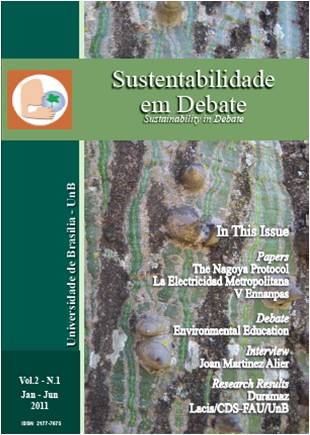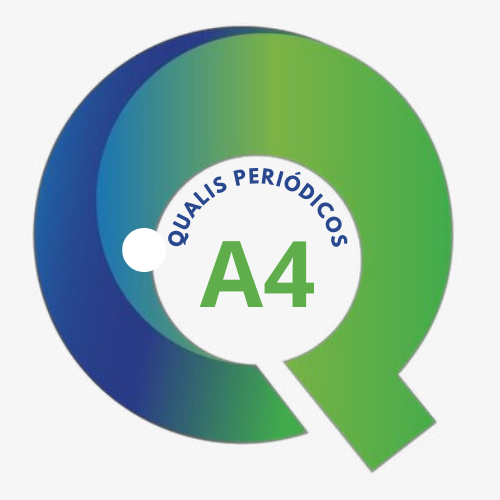DURAMAZ, um Sistema de Indicadores de Desenvolvimento Sustentável na Amazônia
DOI:
https://doi.org/10.18472/SustDeb.v2n1.2011.3916Keywords:
Sustainable development, Amazon, Indicator system, Traditional populationsAbstract
The analysis of sustainability is a big scientific challenge, especially in Amazônia,
a region which has become a kind of open-air laboratory where many
conceptions of what is sustainability are currently being tested. The unveiling of
recurring effects in these experiments, which could constitute key factors of
sustainability in the context of tropical forests, was the main objective of the
DURAMAZ research project, which analyzed the local geographical, social,
demographical or economic impacts of 13 projects of sustainable development
throughout the Amazon. We present in this text the key points of the methodology,
especially the construction of an ad-hoc indicator system, grounded on the databases
elaborated from the information collected in the field, and some conclusions we
were able to reach about sustainability in the Brazilian Amazon region.
Downloads
References
ecossistemas da Amazônia brasileira. Estudos
Avançados, vol. 16, n° 45, 2002, p. 7-30.
ARAÚJO, R. De la “communauté” aux
“populations traditionnelles”. Nuevo Mundo
Mundos Nuevos, Coloquios. Disponivel em :
http://nuevomundo.revues.org/index56593.html.
2009.
BECKER, B. K. Um futuro para a Amazônia.
São Paulo: Oficina de textos, 2008. 150 p.
BENETTI L, B. Avaliação do índice de desenvolvimento
sustentável do mio de Lages (SC)
através do método do painel de
sustentabilidade. Thèse de doctorat de
l’Université de Santa Catarina, 2006. 215 p.
BERG, P. Reinhabiting a separate country, a
bioregional anthology of Northern California.
San Francisco: Planet drum books, 1978. 220 p.
BRONDIZIO, E. S.; OSTROM, E.; YOUNG, O.
J. Connectivity and the Governance of Multilevel
Social Ecological Systems: The Role of Social
Capital. Annual Review of Environment and
Resources, 34, 2009. p. 253”“278
BURSZTYN, M.; SAYAGO, D. A. V.;
TOURRAND, J. F. Amazônia: cenas e cenários.
Brasília: Editora Universidade de Brasília,
2003, v.1. 380 p.
BURSZTYN, M., O poder dos donos.
Petrópolis: Vozes, 1984.178 p.
DALY, H. E.; COBB, Jr. J. B. For the Common
Good: Redirecting the Economy toward
Community, the Environment and a Sustainable
Future. Boston: Beacon Press, 1989. 534 p.
DROULERS, M. ; BROGGIO, C. L’espace et
le développement au Brésil: de la géophagie à la
géosophie? Revue Tiers Monde, n°167, juilsept.
2001, pp. 673-688.
FONSECA, I. F.; BURSZTYN, M. A
Banalização da Sustentabilidade: reflexões sobre
governança ambiental em escala Local. Sociedade
e Estado, Brasília, v. 24, n. 1, p. 17-46,
jan./abr. 2009.
FERNANDES, A.V.; SILVA, L.M.; KHAN, A.S.
Reserva Extrativista do Rio Cajari.
Sustentabilidade e Qualidade de vida. Revista
de Economia e Sociologia Rural, vol 35, n°3,
1997. p. 119-140.
GREISSING, A. ; MARCHAND, G. ; NASUTI,
S. Protéger la forêt et ses traditions grâce à la
certification commerciale? Trois exemples en
aires protégées d’Amazonie brésilienne.
Colloque international Localiser les produits:
une voie durable au service de la diversité
naturelle et culturelle de Sud?, MAB-unesco,
IRD-CIRAD, Paris, 9-11, juin 2009.
GUILLAUMET, J.-L. ; LAQUES, A.-E. ;
LÉNA, P. ; DE ROBERT, P. La spatialisation
de la biodiversité: un outil pour la gestion
durable des territoires. Bondy: IRD, coll. « latitude
23 », 2009, 127 p.
JAH, R.; MURTHY, K.V.B. A critique of the
environmental sustainability index. Australian
national University Division of economics.
Working paper, 33 p. Online: http://
p a p e r s . s s r n . c o m / s o l 3 /
papers.cfm?abstract_id=380160. 2003.
KOHLER, F. Diversité culturelle et diversité
biologique: une approche critique fondée sur le
modèle brésilien. In Natures, Sciences, Sociétés.
(no prelo). 2011.
LE TOURNEAU, F. M. ; GREISSING, A. ;
KOHLER, F. Iratapuru et la noix du Brésil: une
expérience de durabilité en Amazonie brésilienne.
Cybergéo, article n°432. 2008. 1-20 pp.
LOBATO RIBEIRO, A. Modelo de indicadores para mensuração do desenvolvimento sustentável
na Amazônia. Tese de doutorado.
Belém, Universidade Federal do Pará. 2002. 375
p.
MAC GRATH, D. G.; NEPSTAD, D.;
STICKLER, C. Smallholders, rural development
and REDD in the Brazilian Amazon. The Woods
hole research center reports. Online: http://
www.whrc.org/ s.d.
MMA. PPG-7. Subprograma Projetos Demonstrativos.
Estudos da Amazônia: avaliação de 20
projetos. Série Experiências PDA, n° 5, 2004.
80 p.
MOREIRA BRAGA, T.; GONÇALVES DE
FREITAS, A. P. Índice de sustentabilidade local:
uma avaliação da sustentabilidade dos municípios
do entorno do Parque Estadual do Rio
Doce (Minas Gerais). In: Encontro da Associação
Brasileira de Estudos Populacionais
(ABEP), 13 édition, 4-8 novembre 2002, Ouro
Preto (Minas Gerais), 16 p.
PASQUIS, R. (Coord.); FERREIRA NUNES, E.;
LE TOURNEAU, F. M.; MACHADO l.;
MELLO N. A. de. As Amazônias, um mosaico
de visões sobre a região. Brasília: Banco mundial-
CDS/UNB, 2003. 44 p.
PESCHARD, D.; GALAN, M.B.; BOIZARD,
H. Tools for evaluating the environmental impact
of agricultural practices at the farm level: analysis
of 5 agri-environmental methods. Actes du
colloque OCDE expert meeting on farm
management indicators for agriculture and
the environment, 8-12 mars 2004, Nouvelle-
Zélande.
RESCOTT-ALLEN, R. (édition anglophone en
1997) Le bien-être des nations, índice par pays
de la qualité de vie et de l’environnement.
Paris: ESKA, 2003. 368 p.
RAISG (Rede Amazônica de Informação
socioambiental Georeferenciada). Mapa da
Amazônia 2010 ”“ Áreas protegidas e territórios
indígenas. São Paulo: ISA, 2010.
RIST, S.; DAHDOUH-GUEBAS, F.
Ethnosciences - A step towards the integration
of scientific and indigenous forms of knowledge
in the management of natural resources for the
future. Environment, Development and
Sustainability, vol. 8, n° 4, 2006. p. 467-493.
SACHS, I. Ecodesenvolvimento: crescer sem
destruir. Trad. de E. Araujo. São Paulo: Vértice,
1981.
SAWYER, D. Índice de pressão antrópica: uma
proposta metodológica. Brasília, 1997.
SEBILLE, P. ; ARNAULD DE SARTRE, X. ;
DROULERS, M. Rapport de recherche, Action
Concertée Incitative. ACI - Société et culture
dans le développement durable, Dynamique
de peuplement et développement durable en
Amazonie. Enquête biographiques en Amazonie
Brésilienne, EBIMA 2004-2005. CREDAL ”“
Université Sorbonne Nouvelle Paris 3, Paris,
2005. 85 p.
THEYS, J. A la recherche du développement
durable: un détour par les indicateurs. In:
JOLLIVET, M. (Dir.). Le développement
durable, de l’utopie au concept. Elsevier Ed.,
2001.
VAN BELLEN, H. M. Indicadores de
sustentabilidade: uma análise comparativa.
Thèse de doctorat en ingénierie de production,
Universidade Federal de Santa Catarina, 2002.
235 p.
WACKERNAGEL, M.; MONFREDA, C.;
MORAN, D.; WERME, R. P.; GOLDFINGER,
S.; DEUMLING, D.; MURRAY, M. National
Footprint and Biocapacity Accounts 2005: The
underlying calculation method, Global Footprint
network. Disponível em: http://
www.rrcap.unep.org/uneptg05/outline/synthesis/
footprint_method_paper%5b1%5d.pdf, 2005.
Downloads
Published
How to Cite
Issue
Section
License
Copyright (c) 2011 Sustentabilidade em Debate

This work is licensed under a Creative Commons Attribution-NonCommercial-NoDerivatives 4.0 International License.
SUSTAINABILITY IN DEBATE – Copyright Statement
The submission of original scientific work(s) by the authors, as the copyright holders of the text(s) sent to the journal, under the terms of Law 9.610/98, implies in the concession of copyrights of printed and/or digital publication to the Sustainability in Debate Journal of the article(s) approved for publication purposes, in a single issue of the journal. Furthermore, approved scientific work(s) will be released without any charge, or any kind of copyright reimbursement, through the journal’s website, for reading, printing and/or downloading of the text file, from the date of acceptance for publication purposes. Therefore, the authors, when submitting the article (s) to the journal, and gratuitous assignment of copyrights related to the submitted scientific work, are fully aware that they will not be remunerated for the publication of the article(s) in the journal.
The Sustainability in Debate Journal is licensed under Creative Commons License – Non-Commercial-No-Derivation Attribution (Derivative Work Ban) 3.0 Brazil, aiming at dissemination of scientific knowledge, as indicated on the journal's website, which allows the text to be shared, and be recognized in regards to its authorship and original publication in this journal.
Authors are allowed to sign additional contracts separately, for non-exclusive distribution of the works published in the Sustainability in Debate Journal (for example, in a book chapter), provided that it is expressed the texts were originally published in this journal. Authors are allowed and encouraged to publish and distribute their text online, following publication in Sustainability in Debate (e.g. in institutional repositories or their personal pages). The authors expressly agree to the terms of this Copyright Statement, which will be applied following the submission and publishing by this journal.






